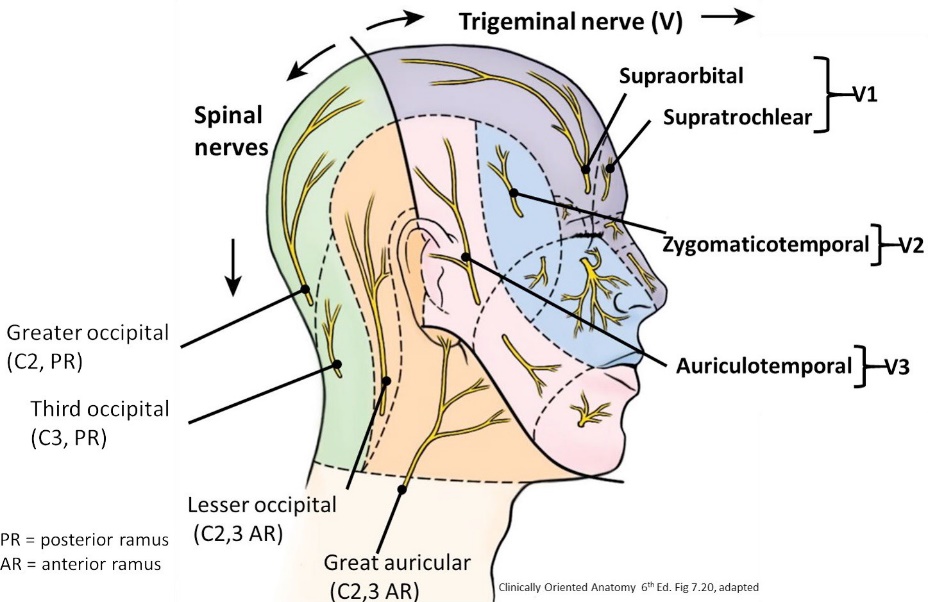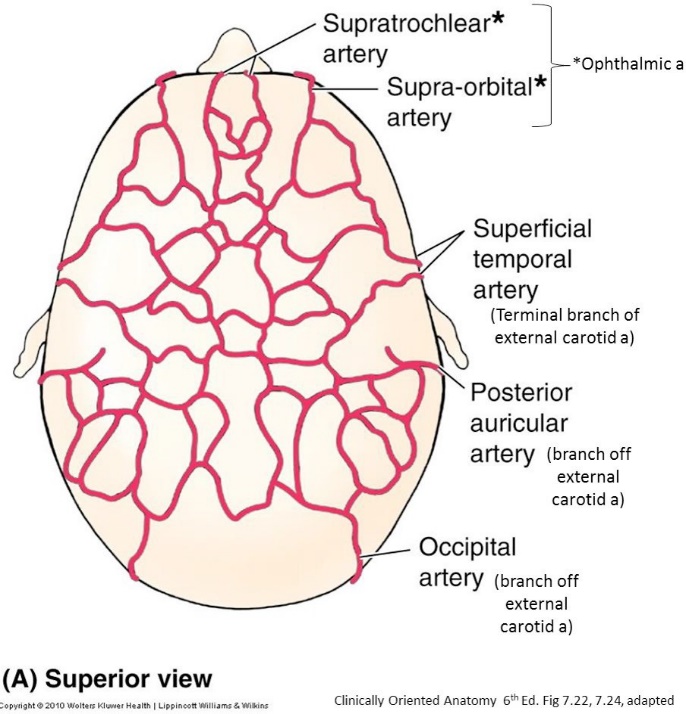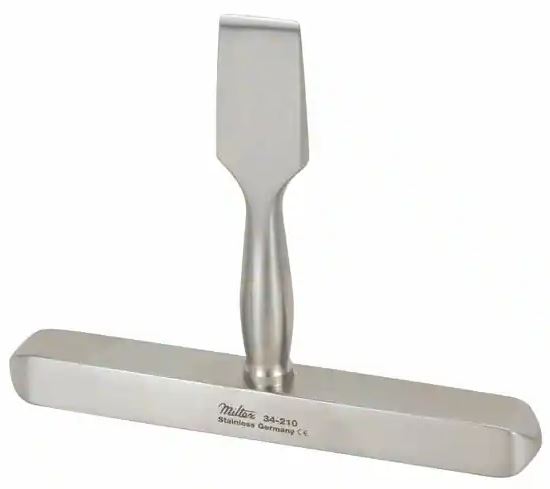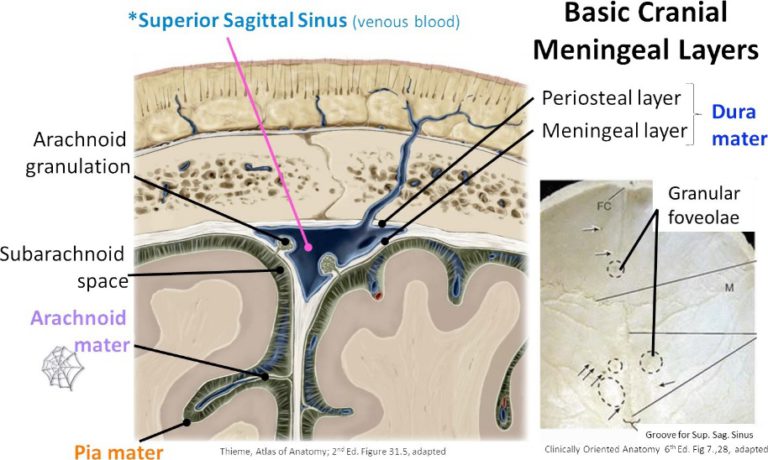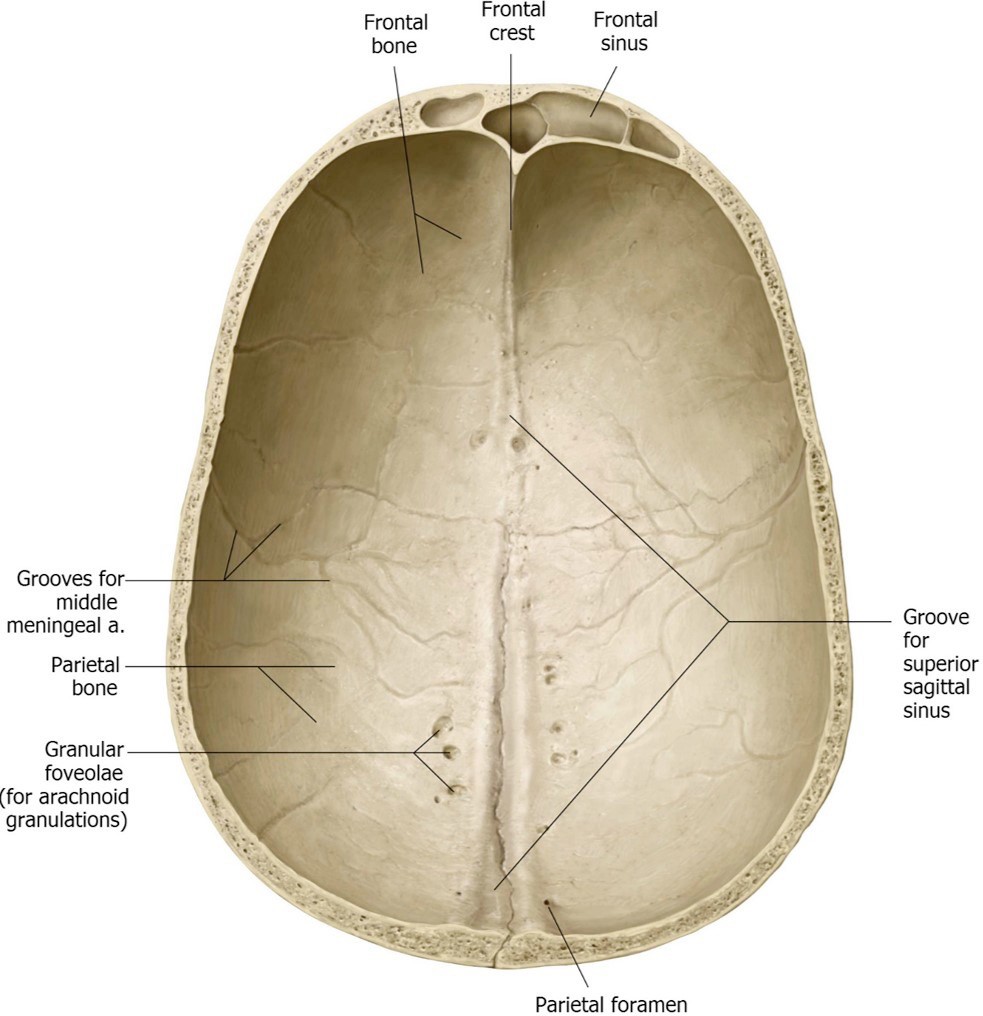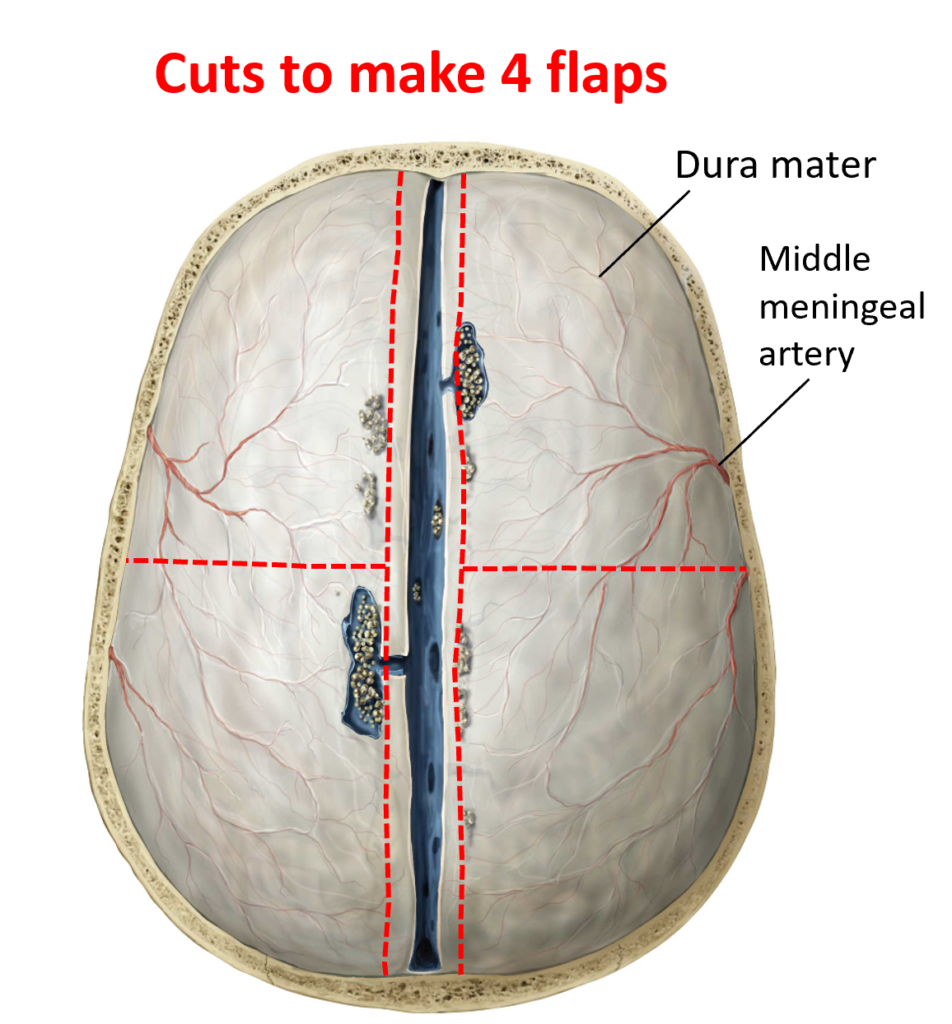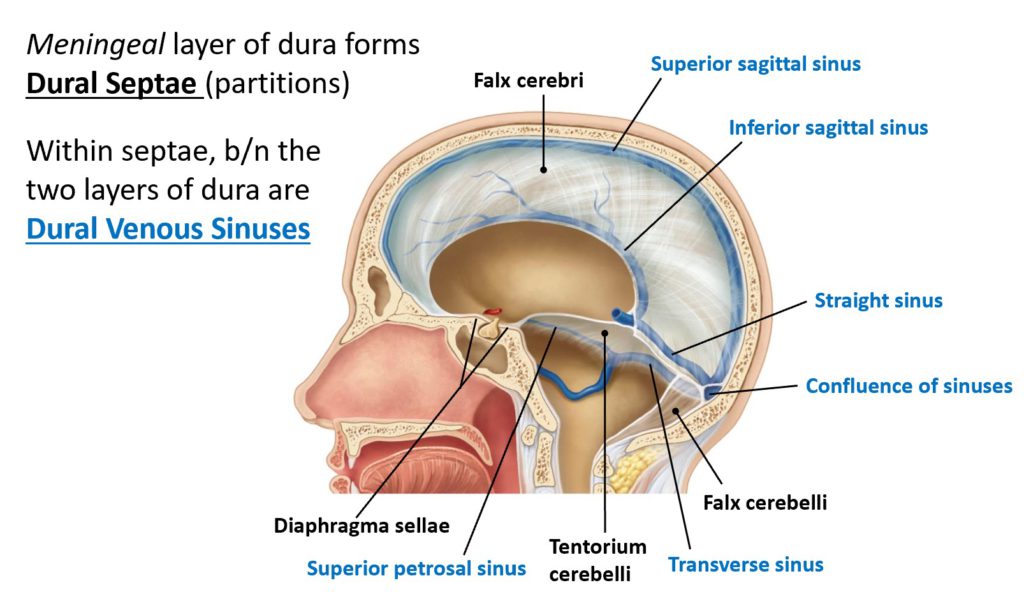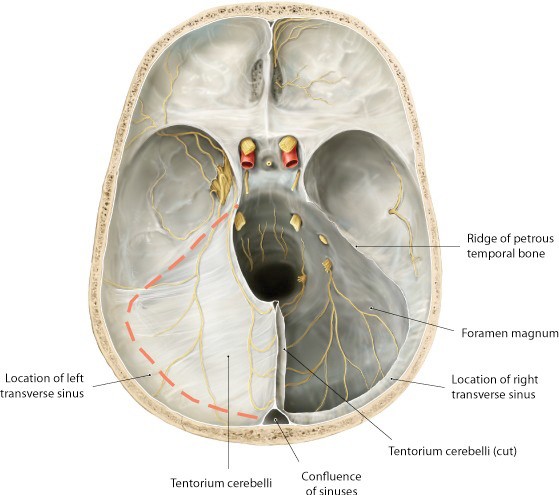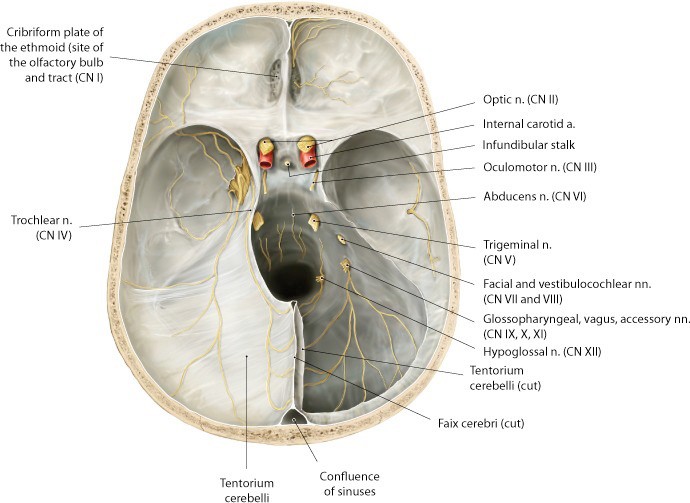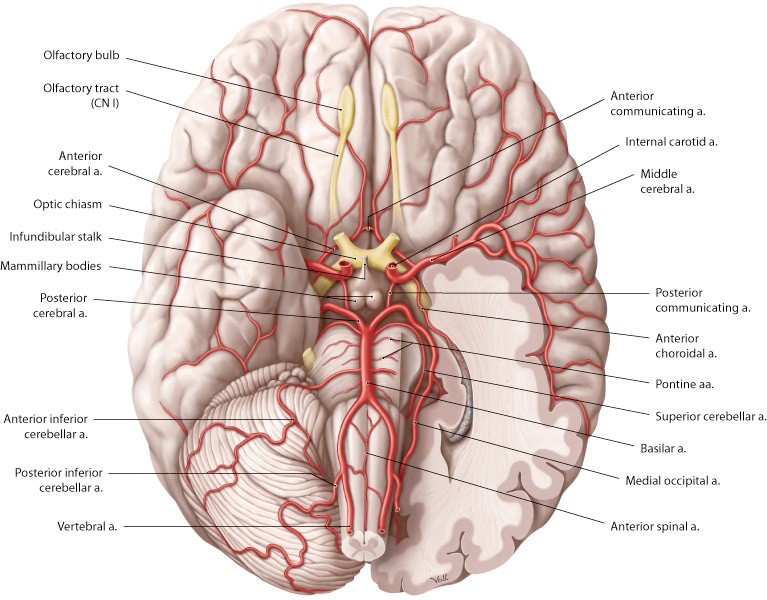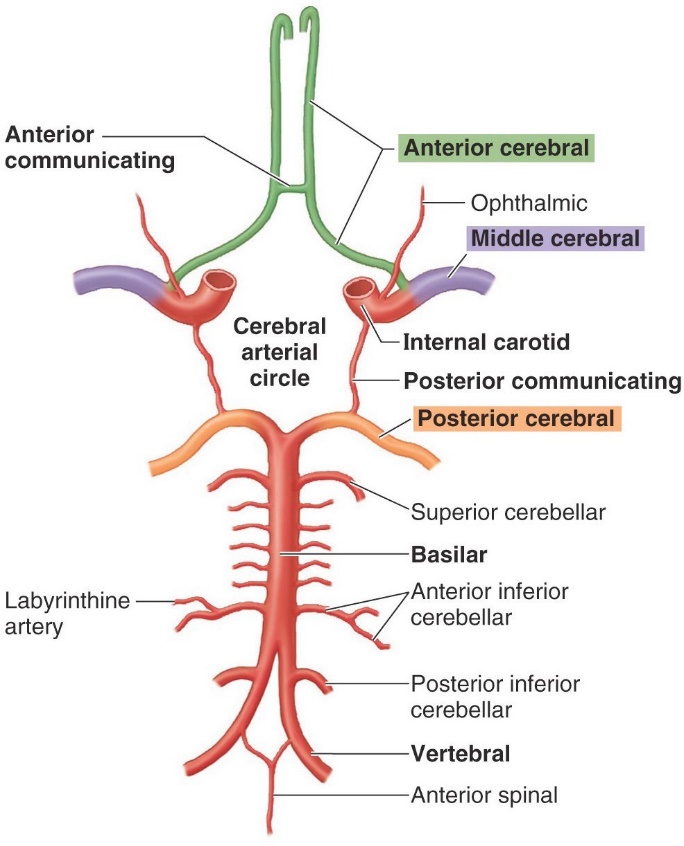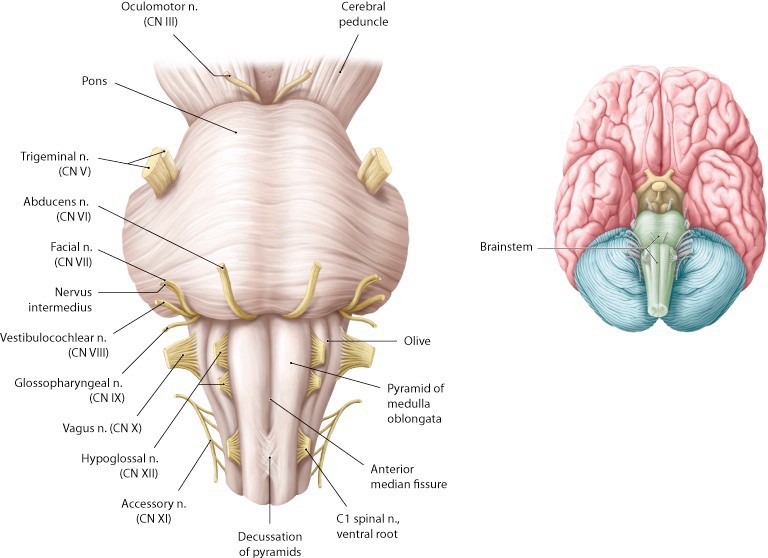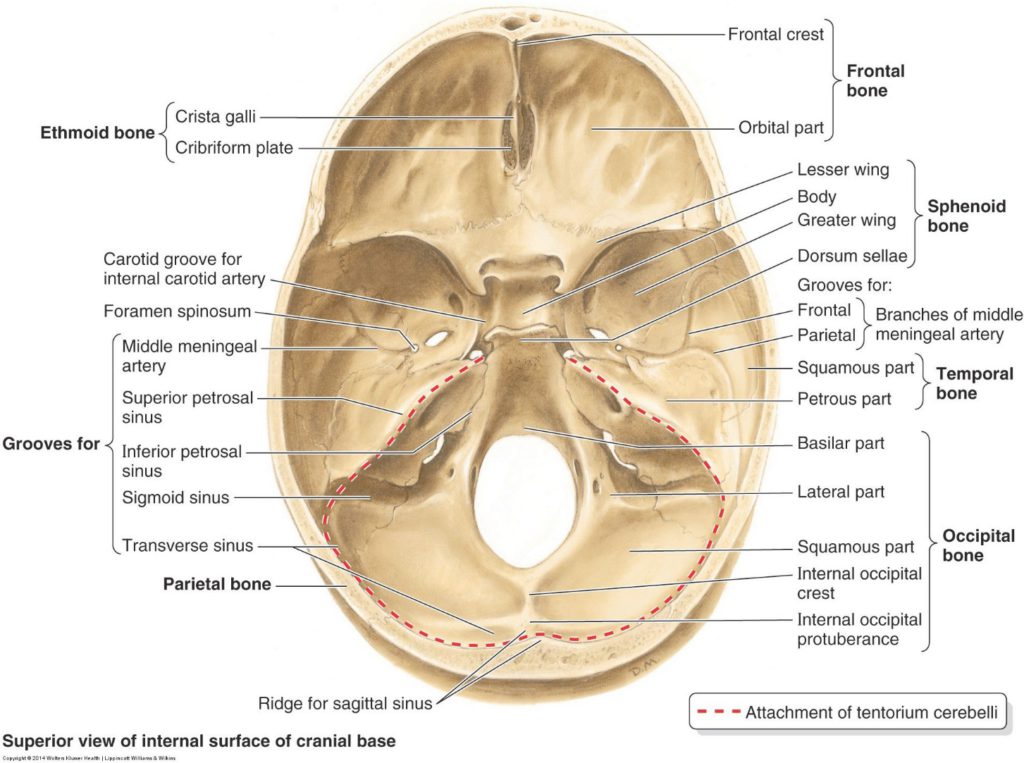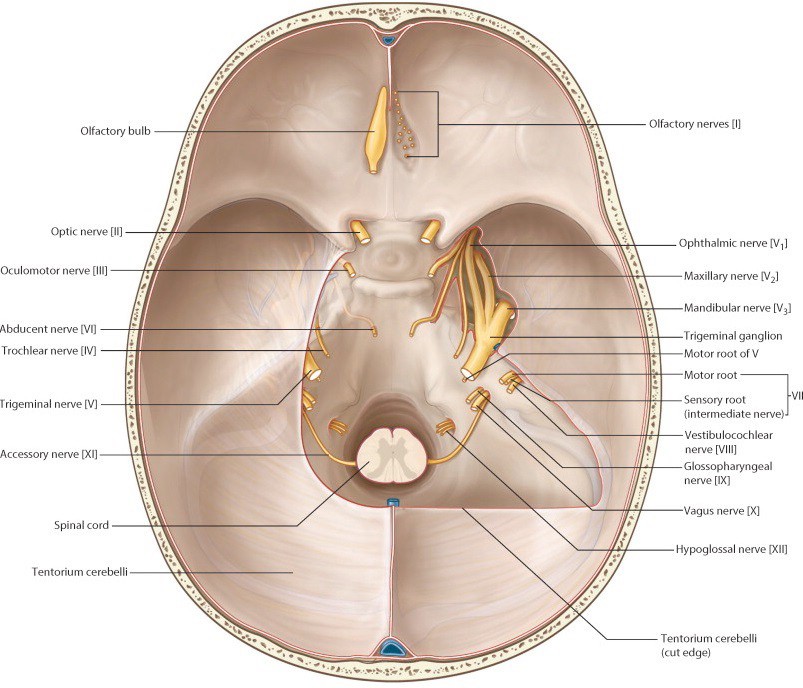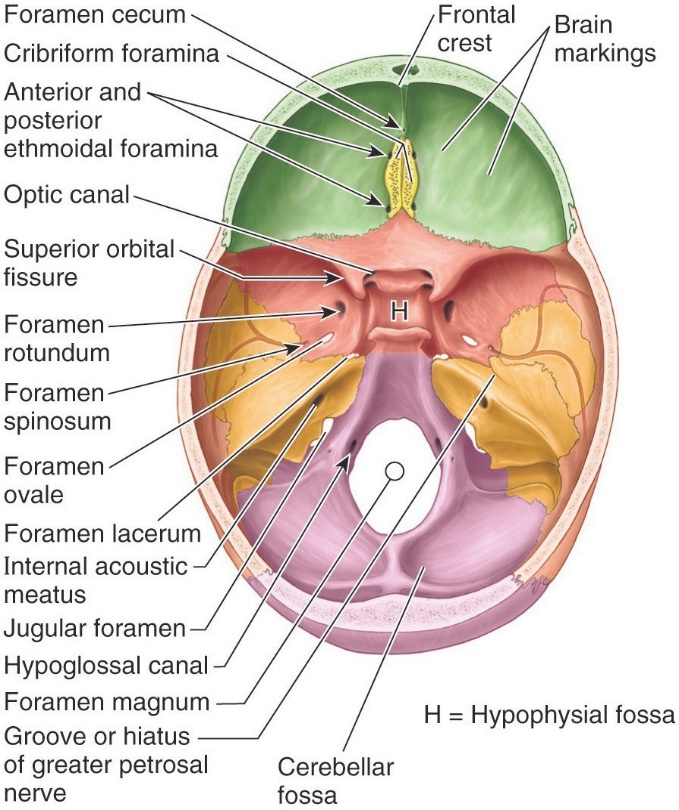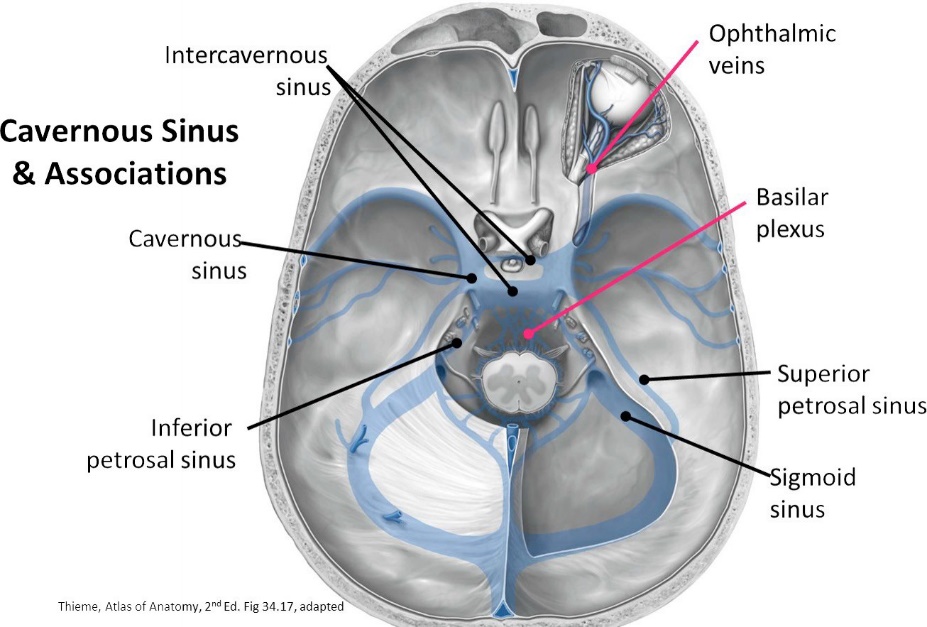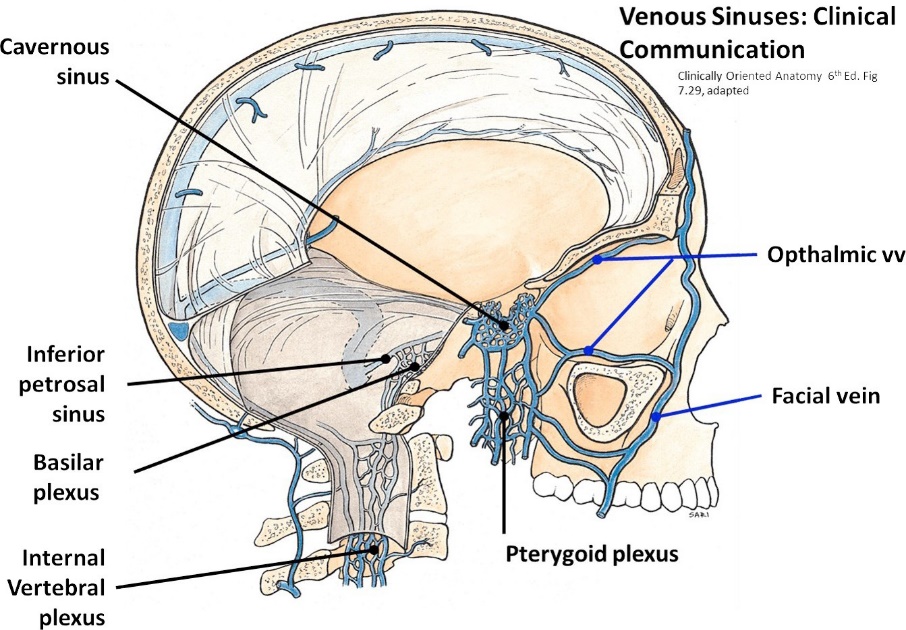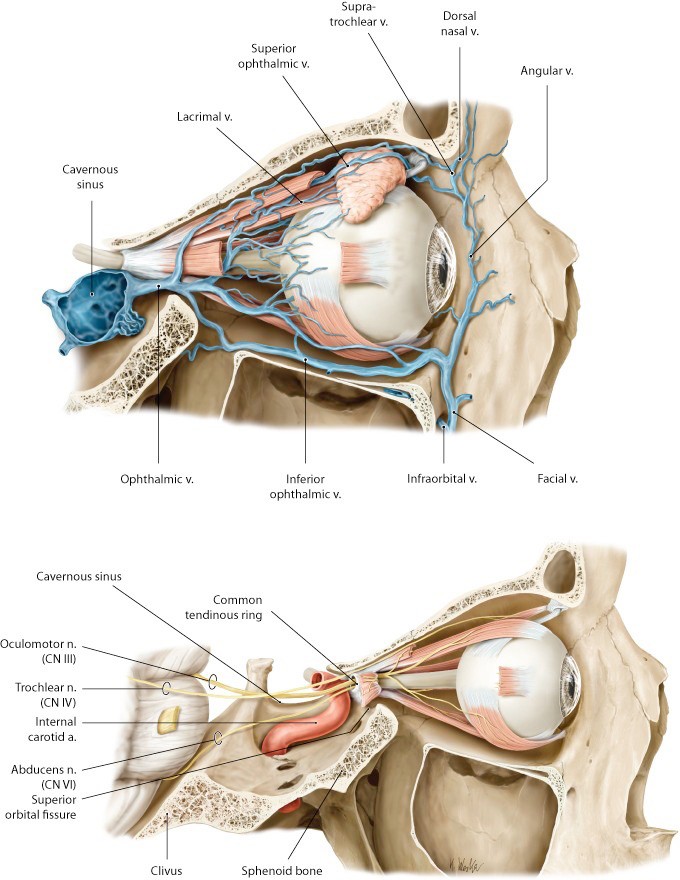1Identify the layers of the SCALP.
2Examine the dura mater and the dural septae.
3Remove the brain and study: meningeal coverings, gross features, and arterial supply (circle of Willis).
4Examine the internal aspect of the base of the skull and the cranial fossae.
5Identify cranial nerves and blood vessels that exit/enter the skull through foramina in the cranial base.
6Identify the dural venous sinuses.
7Open the cavernous sinuses and examine the structures that pass through the sinuses, or are located in their walls.
Scalp
The scalp has been cut into 4 flaps and reflected downward. The skull cap (calvaria) has been cut with a bone saw—extending uniformly around the head above the margin of the orbits anteriorly and above the external occipital protuberance posteriorly.
Layers of the Scalp
The 3 external-most layers of the scalp are the “scalp proper”. Study the flaps in cross-section to identify the layers:
■Skin
■Connective tissue—contains fatty tissue and a lot of dense connective tissue with cutaneous vessels and nerves
■Aponeurosis (epicranial aponeurosis), a flat tendon that connects anteriorly and posteriorly to skeletal muscles (the occipitofrontalis—frontal belly and occipital belly attach on either end of the aponeurosis)
■Loose areolar connective tissue—allows the scalp proper to glide over the skull when it is moved by the occipitofrontalis. The looseness of this layer makes it a “potential space” where fluids can accumulate should the scalp be injured or infected.
■Periosteum—scrape the external surface of the skull. This is the periosteum firmly attached to the connective tissue in the skull sutures.
Nerves and Arteries of the Scalp
Cranial Cavity and Brain
Remove the calvaria.
In order to loosen the calvaria, you may need to insert a chisel and tap it gently with a hammer or use the skull cap removal tool (wide handle with a short chisel- like part). Insert the chisel part into the saw cut and twist it. Do this in several locations around the circumference of the head.
Do your best to peel away both layers of dura from the bone as the calvaria is removed.
The dura mater has an outer endosteal layer (the internal layer of periosteum of the skull cap) and an inner meningeal layer (the dura mater proper).
The endosteal and meningeal layers of dura are fused except in certain places where they are separated to form venous sinuses (e.g., superior sagittal sinus) and where the meningeal layer departs to form dural septa (e.g., falx cerebri).
Ideally, once the calvaria is removed, the dura will be intact, forming a round cap over the brain.
This will NOT be the case in most cadavers since the cap is easily severed with an autopsy saw and may come off with the calvaria.
If the dural cap comes off with the calvaria—turn the skullcap over and strip the dura away. Examine the internal surface of the calvaria.
■Observe the midline impression in the bone made by the superior sagittal sinus.
■Find scattered pits in the bone = these are impressions in the bone made by large arachnoid granulations.
What are arachnoid granulations, and what is their function?
■Look at the cut surface of the calvaria and notice its construction: an outer table of compact bone, an inner table of compact bone, and spongy bone (called diploe) in the middle.
If you were able to save the entire dural cap over the brain = KUDOS!
Tethered to the outside of the dura is the middle meningeal artery (it is sandwiched between the dura and skull bones). The middle meningeal is a branch of the maxillary artery (from the external carotid artery). It is the chief source of blood to the calvaria and its associated dura.
IF you have an intact dura mater, open the dural cap by making four triangular flaps:
1With scissors, make two longitudinal cuts just lateral and parallel to the superior sagittal sinus, from posterior to anterior, leaving the superior sagittal sinus in the strip of dura in the midline of the head.
2Make left and right coronal incisions in the dura starting at midpoints of the incisions you just made and extending down to the cut edge of the skull above the ears.
■Fold the four flaps toward the cut edge of the skull. This will leave the falx cerebri exposed with the superior sagittal sinus in its outer convex border.
Dural Septa
Examine the dural septa (= infoldings of the meningeal layer of the dura). See Figure 25.8.
■Falx cerebri
■Contains the superior sagittal sinus and is located within the longitudinal fissure of the cerebrum, separating the left and right cerebral hemispheres. Its inferior free margin contains the inferior sagittal sinus and relates to the brain’s corpus callosum.
■Tentorium cerebelli
■Elevate the brain’s temporal lobes to see the tentorium cerebelli.
■It attaches to the anterior and posterior clinoid processes of the sphenoid bone, the summit of the petrous temporal bones, and to the internal surface of the occipital bone.
■The attached edges of the tentorium contain the superior petrosal and transverse venous sinuses.
■The left and right portions of the tentorium meet in the midline where it contains the straight venous sinus and where it is attached to the falx cerebri. The midline part of the tentorium is higher than the peripherally attached portions (a sloped tent).
■The tentorium has a gap anteromedially called the tentorial notch that contains the brainstem. The tentorium separates the occipital lobes of the brain from the cerebellum.
■Falx cerebelli
■Lies inferior to the tentorium. It attaches to the midline of the occipital bone and to the inferior surface of the tentorium and it separates the left and right cerebellar hemispheres.
Remove the entire brain.
Standing at the head end of the cadaver, reach around the frontal lobes of the brain and use your fingers to gently lift them from the anterior cranial fossa.
■As you lift, cut the attachment of the falx cerebri from the crista galli of the ethmoid.
■Pull the falx cerebri posteriorly—removing it from its location between the cerebral hemispheres (it is still attached posteriorly to the tentorium cerebelli).
■Lift the right temporal lobe to expose the tentorium cerebelli. Cut the tentorium, from anterior to posterior, where it attaches to the clinoid processes, petrous ridge of the temporal bone, and to the internal surface of the occipital bone. See the dashed line in Figure 25.9.
■Repeat on the left side.
The brain is now “free”. Now what remains is to cut the cranial nerves, cerebral blood vessels, and spinal cord.
Proceed from anterior to posterior; have one member elevate the brain while another cuts.
■Elevate the frontal lobes, carefully peel away the olfactory bulbs and tracts from the skull base while keeping them attached to the brain.
■Cut the optic nerves and internal carotid arteries as they emerge from the skull base.
■Cut cranial nerves III through XII as close to the skull as possible on both sides (as your teammate lifts and tilts the brain).
Before removing,
check that the tentorium cerebelli is cut!
■Finally, elevate the brain and with a long knife, sever the spinal cord and vertebral arteries as far down into the foramen magnum as possible. Remember that you are using these brains for your neuro course! Ask an instructor for help if you are unsure of the procedure.
•Carefully remove the brain from the cadaver and place it onto a tray.
•Review the anatomy of the dural septa that remain in the cranial cavity = falx cerebri, falx cerebelli, and tentorium cerebelli.
Brain: Features and Arteries
Identify the following parts or structures on the brain:
•the lobes of the cerebrum: frontal, parietal, temporal, and occipital
•the cerebellum
•the parts of the brainstem: midbrain, pons, and medulla oblongata
Study the remaining meninges covering the brain (there are now 2).
The arachnoid mater is the outermost shiny layer. It spans across the sulci (invaginations) of the cerebral cortex.
Peel away some of the arachnoid mater to expose the underlying pia mater. This is the most intimate layer of the meninges. It adheres snugly to the cerebrum and follows its contours over the gyri (contours) and down into the sulci.
Examine the meninges on top of the brain along the edges of the longitudinal fissure. Are there any white arachnoid granulations?
Identify the following arteries on the inferior surface of the brain:
■Vertebral artery
■Basilar artery
■Components of the cerebral arterial circle (of Willis)
■posterior cerebral artery
■posterior communicating artery
■internal carotid artery
■anterior cerebral artery
■anterior communicating artery
After you're done with the brain,
put it into the plastic Ziplock bag. Store the brain inside the body bag with your cadaver.
Internal Base of the Skull
Bony Features and Cranial Nerves
Study the bony features of the cranial base in a dried skull. Use a pipe cleaner to identify foramina and other passageways. Correlate the bony features in the skull with what you see in the cranial cavity of your cadaver.
Identify the following parts of the skull in the base of the skull:
■Anterior cranial fossa
■Orbital plates of frontal bone
■Cribriform plate of ethmoid bone (CN I pass through the cribriform foramina)
■Lesser wings of sphenoid bone
■Anterior clinoid processes of sphenoid bone
■Crista galli of ethmoid bone
■Contents of anterior cranial fossa: frontal lobes of brain, olfactory bulbs, olfactory tracts
■Middle cranial fossa
■Greater wings of sphenoid bone
■Squamous and petrous parts of temporal bones
■Optic canals (contain CN II, ophthalmic artery)
■Superior orbital fissures (contain CN IV, III, VI, V1)
■Foramina in middle cranial fossa: foramen rotundum (transmits V2), foramen ovale (transmits V3), spinosum (transmits middle meningeal artery), and foramen lacerum (transmits internal carotid artery)
■Sella turcica and its named parts: hypophysial fossa and dorsum sellae
■Posterior clinioid processes of sphenoid
■Grooves for middle meningeal arteries
■Contents of middle cranial fossa: temporal lobes of brain and hypophysis (pituitary). The pituitary rests in the hypophysial fossa of the sella turcica.
■Posterior cranial fossa
■Clivus (made from sphenoid and occipital bones)
■Internal acoustic meatuses (transmits CN VII, VIII)
■Jugular foramina (transmits CN IX, X, XI; internal jugular vein)
■Foramen magnum (contains spinal cord, CN XI, vertebral arteries)
■Hypoglossal canals (transmits CN XII)
■Grooves for transverse, and sigmoid sinuses
■Contents of posterior cranial fossa: midbrain, pons, medulla oblongata, cerebellum, occipital lobes of brain
In the skull base of your cadaver, can you locate the stumps of all the cranial nerves (I to XII) anterior to posterior? Name their foramina, too!
Dural Venous Sinuses
Locate and name the dural venous sinuses. See Figure 25.18. These are comparable to veins (except they have no middle layer of smooth muscle in their walls) and are created between the meningeal and endosteal layers of the dura.
■Confluence of sinuses
■R & L transverse sinuses: along margins of tentorium cerebelli
■R & L sigmoid sinuses: direct continuations of the transverse sinuses; terminate at jugular foramina
■R & L superior petrosal sinuses: run along summits of petrous ridge
■R & L cavernous sinuses: in the middle cranial fossa, just lateral to the sella turcica
Note that a donut-shaped band of dura overlies the hypophysial fossa in the sella turcica—the hole in the donut transmits the infundibulum (stalk in the pituitary). Where is the pituitary gland?
Trigeminal Nerve
Identify the stump of the trigeminal nerve as it passes over the petrous ridge of the temporal bone. Pass a probe next to the nerve and advance it forward to demonstrate the pocket of dura that surrounds the nerve = this is called the trigeminal (Meckel’s) cave. This outpocketing of dura surrounds CN V and the trigeminal ganglion.
Attempt to strip the dura from the floor of the middle cranial fossa on one side of the cranial cavity.
Note
Use foreceps or a curved clamp to grasp the dura. It's a tough mother!
■Strip the dura from one side to identify the middle meningeal artery and to observe V1 (ophthalmic division), V2 (maxillary division), and V3 (mandibular division) branching from the trigeminal ganglion
■Trace V1 along the lateral wall of the cavernous sinus into the superior orbital fissure.
■Trace V2 into foramen rotundum.
■Trace V3 into foramen ovale.
Cavernous Sinuses
Open one of the cavernous sinuses.
Trace the oculomotor nerve (CN III) forward and note that it lies in the lateral wall of the cavernous sinus.
What other structures lie within the cavernous sinus and its walls? See Figure 25.23.
Note that the Internal carotid artery passes through the center of the sinus. Contemplate this: arterial blood in the ICA is bathed in venous blood. Crazy!
Which cranial nerve is most closely associated with the internal carotid artery within the cavernous sinus?
Checklist, Lab #25
Review and make sure you have identified each of the structures below.
Scalp
Skin
Connective tissue (superficial fascia)
Epicranial aponeurosis
Loose areolar CT layer
Pericranium
Cranial Cavity/Cranial Base
Dura mater
Falx cerebri
Falx cerebelli
Tentorium cerebelli
Tentorial notch
Anterior cranial fossa
Crista galli
Middle cranial fossa
Trigeminal (Meckel’s) cave
Petrous part of temporal bone
Infundibulum of hypophysis
Hypophysis (pituitary gland)
Optic nerve (CN II)
Oculomotor nerve (CN III)
Trochlear nerve (CN IV)
Trigeminal nerve (CN V)
Ophthalmic nerve (V1)
Maxillary nerve (V2)
Mandibular nerve (V3)
Abducens nerve (CN VI)
Internal carotid artery
Posterior cranial fossa
Clivus
Facial nerve (CN VII)
Vestibulocochlear nerve (CN VIII)
Glossopharyngeal nerve (CN IX)
Vagus nerve (CN X)
Spinal accessory nerve (CN XI)
Hypoglossal nerve (CN XII)
Vertebral arteries
Dural Venous Sinuses—identify in cadaver and models
Superior sagittal
Straight sinus
Confluence of sinuses
Transverse sinuses
Sigmoid sinuses
Superior petrosal sinuses
Cavernous sinuses
Brain
Arachnoid mater
Arachnoid granulations
Pia mater
Brainstem: medulla, pons, and midbrain
Cerebellum
Olfactory bulb and tracts
Optic tracts, optic chiasma, and optic nerves
Basilar artery
Posterior cerebral arteries
Posterior communicating arteries
Anterior cerebral arteries
Anterior communicating artery
Skull: Bones of Cranial Vault
Frontal
Ethmoid
Sphenoid
Temporal
Occipital
Parietal
Coronal suture
Sagittal suture
Lambdoidal suture
Squamous suture
Skull: Skull Base
Cribriform plate with Olfactory (cribriform) foramina
Crista galli
Optic canals
Anterior and posterior clinoid processes
Greater and lesser wings of sphenoid bone
Superior orbital fissures
Sella turcica: Includes the hypophysial fossa + dorsum sellae
Foramen rotundum
Foramen ovale
Foramen spinosum
Foramen lacerum
Groove for middle meningeal artery
Clivus
Internal acoustic meatuses
Jugular foramina
Hypoglossal canals
Grooves for transverse sinuses and sigmoid sinuses

